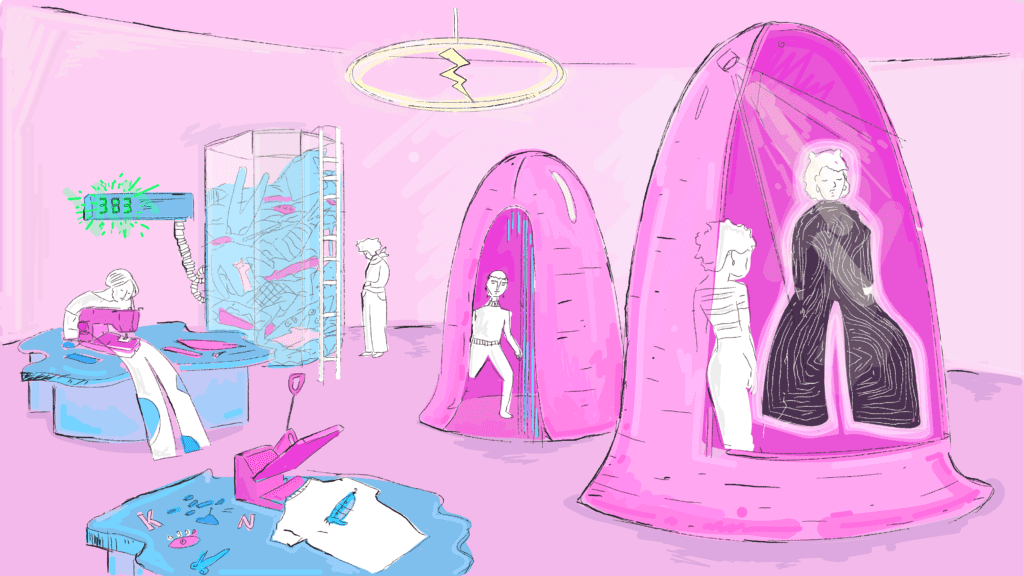Evolving ideas of material ownership and environmental concerns are driving development in the digital fashion space.
When was the last time you physically owned music or a movie? Chances are not recently with monthly subscriptions for Spotify and Netflix slipping out of your bank account. But how about clothing? That’s a different story as our habits are set on purchasing physical apparel. But the tide is changing. Louis Vuitton revealed a collaboration with League of Legends, where gamers can apply ‘skins’ to avatars. Tommy Hilfiger also announced plans to shift over to 100% digital designs by 2022.
The world’s first circular economy store, HOT:SECOND opens in London on November 19th showcasing some of the best digital fashion in the field. We speak to HOT:SECOND’s Founder Karinna Nobbs about why it’s finally time for digital fashion.
RM: Digital fashion is a pretty difficult concept for a lot of people to get their heads around. How would you describe it in layman’s terms?
KN: I try and describe it as a digital layer – akin to a Snapchat filter, but in full body length and one that focuses on clothing. It’s an added layer of digital content that is clothing related. The issue is that this digital layer currently only exists on specific platforms and until it can be applied onto multiple places, then its adoption will finally hit its tipping point.
RM: ‘Wearable tech’ was a bit of a buzzword five years ago or so, but after hype died down, we’re now left with little in the way of strong legacies in brands or products. What sets digital fashion apart from wearable tech?
KN: In the last year, we’ve seen companies like Puma and Vetements invest in garments that have hidden or overt QR code prints. The product then has a digital layer when you use them in conjunction with the branded app. That’s a kind of evolution where wearables are at, where you could have a different t-shirt every day just based on content that could be unlocked or something similar to the web AR experience such as Holition’s make up try on for Covergirl. The issue is you either have to program a web based AR product or download an app. Research suggests it can lead to app fatigue for consumers, unless they’re a real super fan of the brand. All social platforms are trying to crack body tracking. Once that is well-established we’ll start to see our clothes come to life more, where software wearables will be more prominent compared to hardware based wearables.
RM: How can digital fashion work with boomers or less digital native people, where is the opportunity there?
KN: In the short term, I’ve taken a leap of faith to create something relatable in the HOT:SECOND experience with an Easter egg using a costume from a famous musical artist. After speaking to consumers, many talked about wanting to try on something from history, whether that’s Napoleon’s outfit or Princess Diana’s wedding dress. So when you put something like an AR photo booth, inside somewhere like the V&A or a cultural institution, that’s where there’s quite a nice fit by creating a fun digital memory of your time. It’s playful and entertaining, along with an education aspect to go along with it as well. In the long-run, consumers also vocalized they’d love to use this technology in store to get a feel for the products and see if it suits them. This is something easily digestible for boomers first exposed to digital fashion.
RM: The way we’ve seen digital fashion manifest up until this point mainly is across the premium and luxury space, who’s leading the charge in that area?
KN: In my survey on digital fashion, almost half of all participants said luxury is the first category they’d try. It would work best at department stores with multi brands like Harrods, Harvey Nichols and Galeries Lafayette to experiment with this as a type of advertising tool.. Right now, everybody’s waiting for the first person to do it. Louis Vuitton did a digital collection for League of Legends, but it is still more aligned to gaming than fashion. Until we’re able to authenticate and control the asset and how it is traded, we won’t see many luxury brands invested in it yet.
RM: At the opposite end of the spectrum, who in the lower end of the market can you see experimenting in this space, do you think that there’s value to them at the moment?
KN: There’s a good news story and PR value in experimenting with digital fashion as it emerges. The real objective is how to scale it to the market. One thing that comes through strongly in the research I’ve done, is that digital clothing could be the best way for influencers to demonstrate their relationship with a product. This might be the best way the middle market could share a digital asset with a number of influencers. From a sustainability perspective, brands don’t have to make physical samples and save on resources.
RM: Digital design is flipping the current structure of the industry on its head. Are the pathways in our education system strong enough to set people up for this or are people learning this kind of skill themselves?
KN: It’s very much in development. Particularly with fashion design schools, the forward thinking people are the ones leading those programs. For instance, RCA and Parsons have both integrated CLO3D, which tends to be the main 3D digital design package that fashion designers are using at the moment. We’ll see that trickle down into other universities, where it will be an integral part of the curriculum within the next three to five years.
RM: The visuals that I’ve come across around digital fashion so far feel like more of an art form than anything else. Do you think for that reason that it feels a little bit out of reach to some people?
KN: That’s the main reason I wanted to give people at the concept store a range of fashion experiences. I choose The Fabricant because their designs are quite avant garde and ethereal and not what you could necessarily wear to the shops. Then Carlings, which is much more street fashion, along with looking into garments that digitally look like they’re on fire or frozen. The exciting thing about digital fashion is that it offers this ability to try and have access to things you wouldn’t normally do in real life.
RM: HOT:SECOND is described as the world’s first circular economy concept store. Can you explain a bit about what first prompted you to explore that as an idea?
KN: It was mainly that horrendous statistic about 11 million garments in landfills. Initially I thought it was 11 million a year, but it’s 11 million a week just in the UK. As soon as I started following the PR stories around Carlings and The Fabricant, I was fascinated by the subject area and thought there must be a relationship between those two things; digital fashion being the ways to potentially get a fashion fix. After speaking to consumers and people within the industry, everybody was scratching their heads on how to solve the waste issue. My background as a researcher made me jump into that space to try and offer some kind of contribution.
RM: Do you think that sustainability is the most important factor that’s driving the movement more so than ever?
KN: No, it’s an appetite for novelty and innovation first. There are some people like The Fabricant who are hugely passionate about that and are driven to create a positive impact on the planet by migrating certain creative processes to digital only. But my general feeling is that it’s more about newness, innovation and change. The sustainability part is very close, but it’s not as massive as the former. Although it was the landfill figure that got me thinking about what to do, it was more the notion of trying to make something that’s unknown.
RM: What can people expect when they visit HOT:SECOND?
KN: In exchange for trying the digital fashion people will donate a garment that they don’t want anymore to Love Not Landfill as the goal is to save 500 garments within the time the space is open. Different types of customization artists will come in each day to customize something that you currently have so hopefully you’ll love it a little bit longer and won’t end up in landfill. There’s quite an intensive event program with practical activism with extinction rebellion, an event on digital wellbeing and a panel on digital authenticity.
The actual experience itself is a guided one as it requires talking to a human to explain how it works and the story behind it. The balance of physical, human and digital needs to be right. So you’re in the booth with your digital tailor – The Fabricant, Carlings, Christopher Raeburn as well as the Easter egg. By taking pictures of yourself in these outfits, people take both a digital and experiential memory with them.
HOT:SECOND runs November 19th to 21st at Protein Studios in Shoreditch, London.Most Popular

